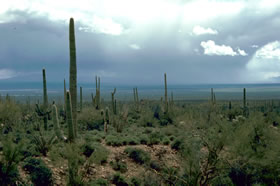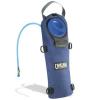
Hiking Gear Guide
Hydration Systems

 |
Hiking Gear Guide
|
 |
| Home > Hiking Gear > Hydration Systems | Search Site |
Hiking Gear
|
Hydration Systems
|
 |
| Don't always count on finding water when hiking in Montana |
| Photo Courtesy of DLS Image Library |
Hydration systems are relatively new to the world of hiking. Not too long ago, to carry water for hiking you either used a water bottle, canteen or one of those old fashioned water slings (all of which work reasonably well). Technology, though, has provided a much better way to carry water for hiking in the form of a "hydration system," also known as a hydration pack.
This guide to hydration systems and hydratioin packs will go over what they are, what you should look for when shopping around for one and why, quite simply, you should get one. While water bottles will never disappear and will always be handy, a good hydration system makes staying hydrated easier and makes carrying around water far less awkward.
| View Hydration Packs at REI |
 |
| A Typical Hydration System |
A hydration system is essentially a specialized "bag of water" that can either be put either into a hydration pocket on a compatible pack or put right inside the pack itself. Additionally, there are now many packs that are called Hydration Packs. These types of packs already have the hydration system "built into" the pack.
The hydration system also has a drinking tube. The drinking tube is essentially a very long straw that is connected to the "bag of water." The drinking tube on a hydration pack allows the hiker to effortlessly grab a drink of water, avoiding the hassle of having to dig out a water bottle from a hard to reach external pocket or having to take off the pack to fetch water from inside the pack.
As mentioned, water in a hydration system is essentially stored in a "bag of water." Now, this is no ordinary bag. Instead, the bag is specialized plastic that is able to be completely frozen without any danger of it cracking. Additionally, the specialized plastic also prevents a "plastic taste" from being transferred to the water.
There are many benefits to using hydration systems when hiking. Listed below are just some of the many benefits.
Easy to Keep Hydrated : This is the biggest advantage, of course.
The drinking tube of a hydration system makes it incredibly simple to
just "take a sip" of water whenever needed. Gone are the days
of having to fumble out a water bottle from an external pocket or from
deep inside the pack. Because drinking is so simple with a hydration
system, in general, and due to human nature, a hiker will stay better
hydrated.
Compact Size : Hydration systems come in a wide variety of sizes, with 70
ounce storage systems probably being the most common. What is nice about hydration
systems, though, is that they are not "hard sided" like a normal
plastic water bottle or canteen is. Thus, as water is withdrawn from the "bag",
the size of the "bag" thus shrinks. Moreover, since the bag is soft,
it can be squeezed into all sorts of corners of a pack.
Durability : Hydration systems are incredibly durable. They are made of very
tough plastic that will not leak or puncture (unless you take a knife to it,
of course), but can also be frozen. Indeed, that is one of the nice things
about them. You can freeze some water and then, as it melts while out on the
trail, you are guaranteed some nice, cold water. Water bottles, by contrast,
don't react well at all to being frozen, and will generally crack if frozen,
especially if the bottle is full.
Cost : A hydration system is more expensive than a water bottle. However,
the extra cost is a bit illusory. Here's why. For around $30, you can get a
full hydration system with everything you need that will hold 70+ ounces of
water. If you go the water bottle route, you first need to buy two water bottles
for around $12 (a standard water bottle holds 32 ounces). Then you'll probably
want to get at least one external water bottle holder to attach to your packs
hip belt (which makes it easier to grab a drink when you want it), adding another
$5 per holder to the final cost. Thus, you don't really save much money in
my opinion by going the water bottle route - and you lose out on the ease of
use of the hydration systems. For me, at least, using a hydration system is
a "no brainer" for the active hiker.
| Montana Web Cams | Montana Information | Fly Fishing Gear | Fishing Boats | About | Contact Us | Advertising Information | Privacy Policy |